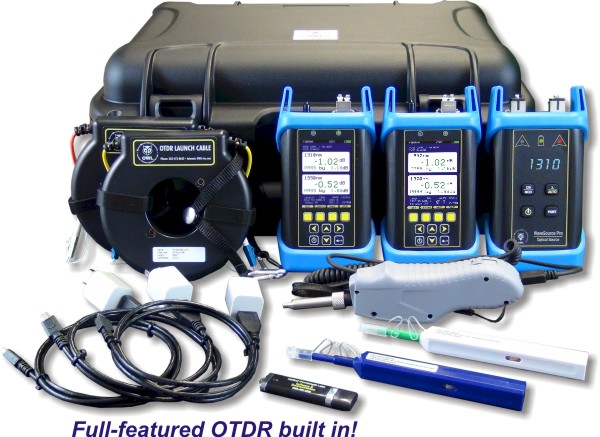Important Features to Seek in Optical Fibre Screening Tools
When examining optical fibre testing devices, numerous vital features warrant careful consideration to guarantee optimum performance and dependability. Compatibility with existing industry requirements boosts performance, while advanced dimension abilities, consisting of TDR and OTDR testing, deal vital understandings right into network integrity. Understanding these attributes will drop light on just how to choose the right devices for your particular demands.
Precision and Accuracy
Accuracy and precision are vital parameters in the examination of optical fiber screening tools. These two qualities make certain that dimensions mirror the real performance of fibre optic systems, which is important for efficient network installation, upkeep, and troubleshooting. Precision describes the nearness of a gauged worth to the actual worth, while precision denotes the repeatability of measurements under unmodified problems.
When choosing optical fiber testing equipment, it is important to take into consideration instruments that offer high accuracy and accuracy to minimize errors in information analysis. Instruments such as optical time-domain reflectometers (OTDRs) and power meters must have calibration mechanisms to guarantee constant efficiency in time. Additionally, the requirements given by producers need to information the tools's dimension unpredictability, which directly impacts the dependability of examination results.
Additionally, the efficiency of optical fiber screening tools can be influenced by ecological elements, such as temperature and moisture. Choosing tools designed to reduce these variables will enhance measurement integrity. Finally, investing in optical fibre testing devices with durable accuracy and accuracy attributes is basic for preserving optimum network efficiency and making certain the stability of fibre optic interactions.

User-Friendly User Interface
The performance of optical fibre testing devices is not entirely figured out by its accuracy and precision; a straightforward user interface plays a significant duty in enhancing functional efficiency. A well-designed interface streamlines the communication in between the service technician and the devices, enabling a more intuitive understanding of complex functions.
Secret features of an easy to use user interface consist of clear navigating menus, logical formats, and easily available controls. These components enable professionals to execute examinations swiftly without comprehensive training, lowering the chance of user error - ofda. Additionally, aesthetic indications such as development bars, informs, and graphical depictions of data can substantially boost the customer experience by providing prompt responses on the screening process.
Furthermore, personalized setups can further improve operations by permitting individuals to readjust specifications according to certain screening demands. This versatility not only conserves time yet also makes certain that the devices meets diverse application needs.
Incorporating help functions, such as tooltips and thorough handbooks, right into the interface can additionally empower individuals, advertising self-sufficiency and self-confidence in running the devices. Ultimately, a straightforward interface is important for making the most of the capacity of optical fibre testing equipment, resulting in a lot more efficient and effective testing end results.
Mobility and Resilience
Portability and resilience are critical features of optical fiber testing devices, making sure that it can endure the roughness of different settings while remaining simple to transport. Technicians frequently function in diverse settings, from telecommunications hubs to remote setups, making it critical that screening tools are light-weight and compact (ofda). Devices designed with portability in mind commonly includes ergonomic manages and instances that promote effortless motion, hence enhancing operational efficiency on-site
Durability is equally vital, as optical fiber screening devices is frequently subjected to rough conditions, consisting of temperature fluctuations, wetness, and physical impacts. Gadgets constructed with sturdy products such as reinforced plastics or steel real estates are much better suited for these settings, lessening the threat of damage during use and transportation. Additionally, devices with water and dirt resistance rankings, such as IP ratings, guarantees reliable performance click to investigate in challenging problems.
Compatibility With Specifications
Making sure compatibility with industry criteria is essential for optical fiber testing equipment, as it straight influences the dependability and validity of examination results. Optical fibre networks are subject to stringent efficiency requirements established by numerous companies, including the Telecoms Industry Organization (TIA) and the International Electrotechnical Commission (IEC) Examining tools has to comply with these requirements to ensure that dimensions correspond and comparable across various systems and atmospheres.
When picking optical fibre screening equipment, individuals should confirm that the tool satisfies pertinent standards significant to their particular application, such as those pertaining to attenuation, data transfer, and crosstalk. Tools that is compliant with well established standards not only aids in achieving precise outcomes yet also assists in interoperability amongst devices from different suppliers.
Additionally, compatibility with requirements makes sure that the tools can be used in regulative conformity circumstances, which is crucial for jobs in markets such as telecoms, aerospace, and military applications. Spending in optical fibre testing devices that lines up with present sector criteria is a basic facet of keeping top quality guarantee and attaining optimum network efficiency.
Advanced Dimension Capacities
Advanced dimension capacities are a specifying function of contemporary optical fiber testing devices, permitting extensive analysis of network performance. These capabilities ensure that service technicians can review critical parameters such as signal loss, diffusion, and bandwidth, which are important for maintaining optimal communication efficiency.
One key facet is the capacity to carry out time-domain reflectometry (TDR) and optical time-domain reflectometry (OTDR) tests. These strategies make it possible for individuals to determine faults, gauge the length of fibres, and establish the place of problems with remarkable accuracy - ofda. Advanced tools typically includes the ability to measure optical power degrees, helping to analyze the overall wellness of the network and read what he said guarantee conformity with the required requirements.
Additionally, some testing tools offer sophisticated algorithms for real-time analysis, allowing quicker medical diagnosis and troubleshooting. In verdict, spending in optical fibre testing equipment with innovative dimension capabilities is vital for making sure network integrity and efficiency in today's requiring telecommunications landscape.
Conclusion
